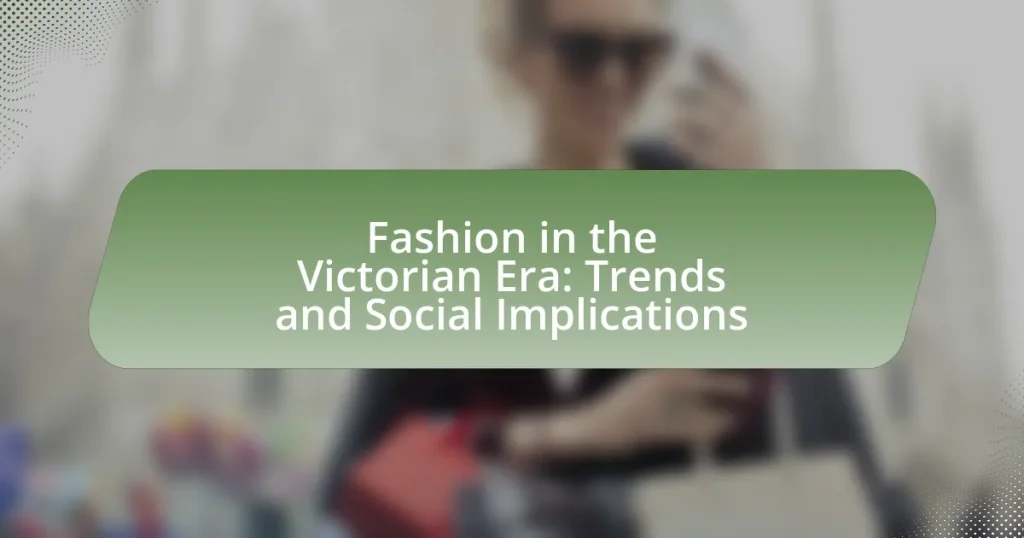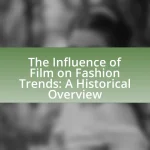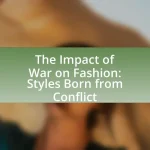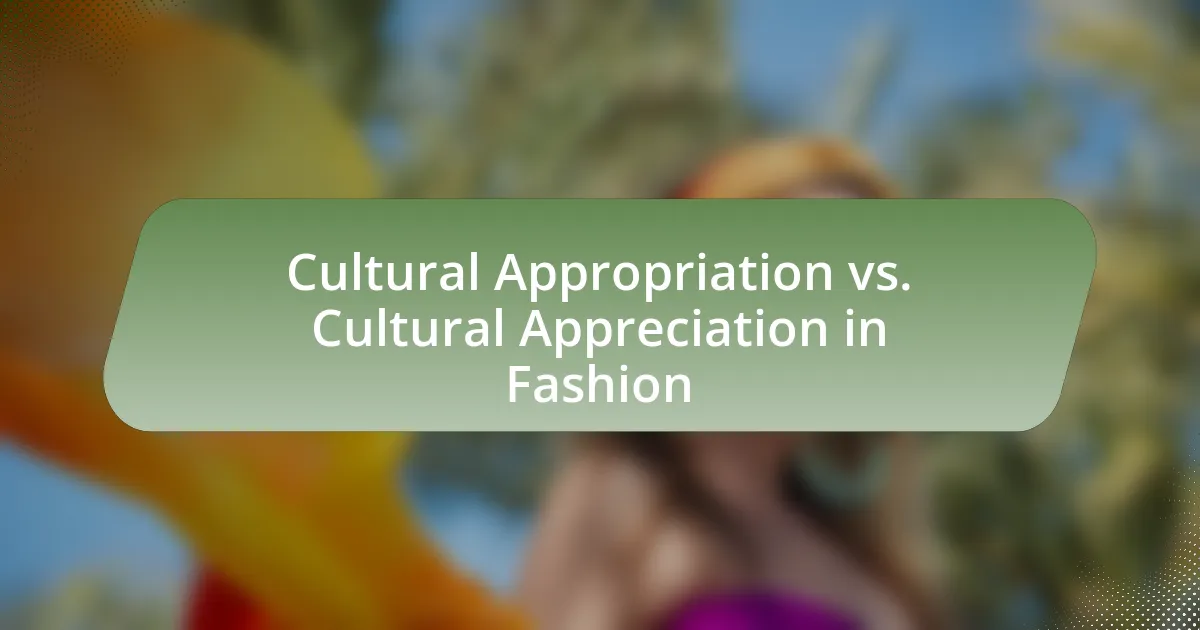Fashion in the Victorian Era, spanning from 1837 to 1901, is characterized by its emphasis on modesty, elaborate designs, and strict social codes that reflected the era’s class distinctions and gender roles. Women’s fashion featured corsets, full skirts, and intricate embellishments, while men’s attire included tailored suits and waistcoats. The article explores how societal norms influenced fashion choices, the impact of technological advancements like the sewing machine, and the role of fashion in reinforcing social hierarchies. Additionally, it examines the lasting effects of Victorian fashion on modern trends and the lessons that can be learned regarding social identity and craftsmanship in contemporary fashion practices.
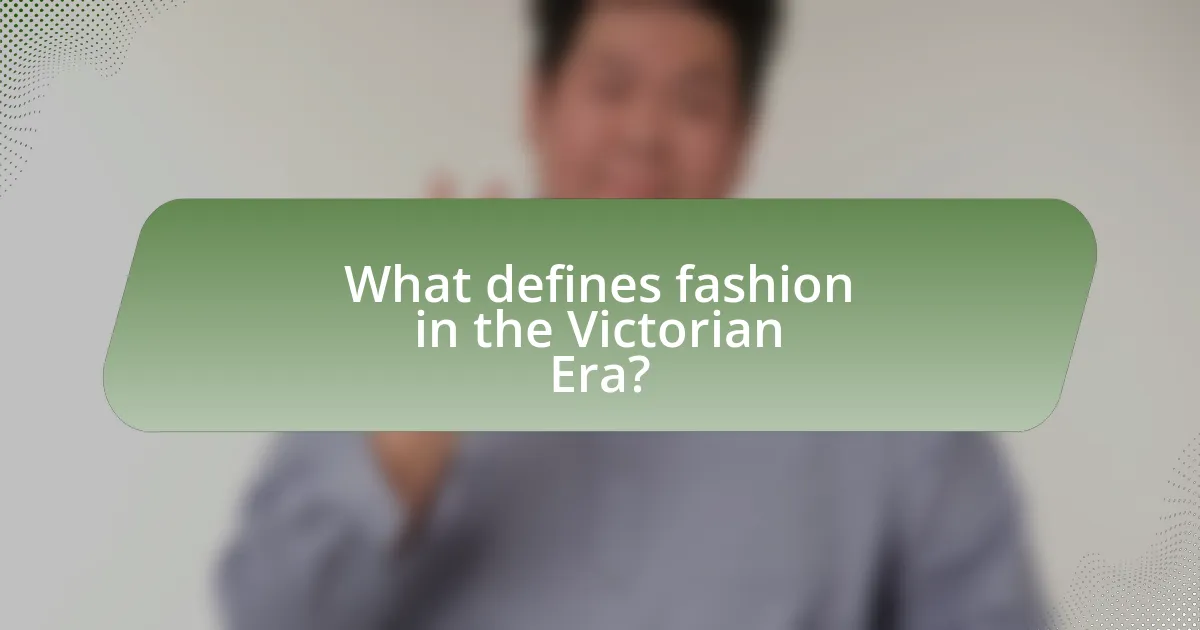
What defines fashion in the Victorian Era?
Fashion in the Victorian Era is defined by its emphasis on modesty, elaborate designs, and strict social codes. The period, spanning from 1837 to 1901, showcased a variety of styles that reflected the social hierarchy and gender roles of the time. Women’s fashion featured corsets, full skirts supported by crinolines, and intricate embellishments, while men’s fashion included tailored suits and waistcoats, emphasizing a polished appearance. The use of fabrics such as silk, lace, and velvet was prevalent, and the introduction of the sewing machine in the mid-19th century allowed for more intricate designs and mass production. This era’s fashion not only highlighted individual status but also reinforced societal norms, as clothing choices were often dictated by class and occasion.
How did societal norms influence Victorian fashion?
Societal norms significantly influenced Victorian fashion by dictating the styles, materials, and behaviors associated with clothing. The strict class hierarchy of the Victorian era mandated that fashion reflected one’s social status, leading to elaborate garments for the upper classes, such as corsets and crinolines, while the working class wore simpler, more practical attire. Additionally, gender roles shaped fashion; women were expected to wear modest, restrictive clothing that emphasized femininity, while men’s fashion focused on tailored suits that conveyed authority and professionalism. The emphasis on morality and propriety during this period also led to the popularity of garments that covered the body extensively, reinforcing societal expectations of modesty. Historical evidence shows that fashion magazines and societal commentary of the time reinforced these norms, further embedding them into the fabric of Victorian society.
What role did class distinctions play in fashion choices?
Class distinctions significantly influenced fashion choices during the Victorian Era, as clothing served as a visible marker of social status. The upper class showcased wealth through luxurious fabrics, intricate designs, and elaborate accessories, while the lower classes wore simpler, more practical garments made from less expensive materials. For example, the use of silk and lace was prevalent among the affluent, whereas the working class typically wore cotton or wool. This differentiation in attire not only reflected economic disparities but also reinforced social hierarchies, as fashion became a means of both expressing and enforcing class identity.
How did gender roles shape clothing styles during this period?
Gender roles significantly shaped clothing styles during the Victorian Era by enforcing distinct sartorial norms for men and women. Men’s fashion emphasized practicality and authority, featuring tailored suits and functional attire that reflected their roles as breadwinners and public figures. In contrast, women’s clothing was characterized by elaborate designs, corsets, and voluminous skirts, which reinforced ideals of femininity, domesticity, and moral virtue. This differentiation in styles was rooted in societal expectations; for instance, the restrictive nature of women’s garments symbolized their limited public roles and the emphasis on modesty. Historical evidence shows that the Industrial Revolution further entrenched these roles, as mass production made clothing more accessible, yet still adhered to gender-specific designs that mirrored societal hierarchies.
What were the key fashion trends of the Victorian Era?
The key fashion trends of the Victorian Era included the use of corsets, full skirts, and elaborate fabrics. Corsets were essential for achieving the desired hourglass figure, while skirts often featured crinolines or bustles to create volume. Fabrics such as silk, velvet, and lace were commonly used, reflecting the era’s emphasis on opulence and detail. Additionally, men’s fashion saw the popularity of tailored suits, waistcoats, and top hats, which signified social status and respectability. These trends were influenced by the Industrial Revolution, which made textiles more accessible, and they also mirrored the strict social hierarchies and gender roles of the time.
What types of garments were popular among women?
During the Victorian Era, popular garments among women included dresses, corsets, and petticoats. Dresses were characterized by their elaborate designs, often featuring full skirts supported by crinolines or bustles, which emphasized a woman’s silhouette. Corsets were essential for achieving the desired hourglass figure, reflecting societal standards of beauty and femininity. Petticoats, worn underneath dresses, added volume and shape, further enhancing the overall appearance. These garments not only represented fashion trends but also indicated social status and adherence to the cultural norms of the time.
What styles were favored by men during this time?
During the Victorian Era, men favored styles characterized by tailored suits, waistcoats, and top hats. The three-piece suit, consisting of trousers, a jacket, and a waistcoat, became a staple, reflecting the era’s emphasis on propriety and social status. Additionally, frock coats and morning coats were popular for formal occasions, while bowler hats emerged as a fashionable choice for everyday wear. This preference for structured and formal attire was influenced by the societal norms of the time, which valued respectability and a polished appearance.
How did technological advancements impact Victorian fashion?
Technological advancements significantly transformed Victorian fashion by introducing new materials and manufacturing processes. The invention of the sewing machine in the 1840s allowed for faster production of garments, making fashionable clothing more accessible to the middle class. Additionally, the development of synthetic dyes in the 1850s expanded color options, enabling more vibrant and diverse clothing styles. The use of the Jacquard loom facilitated intricate patterns in fabrics, enhancing the aesthetic appeal of garments. These innovations not only democratized fashion but also reflected the era’s industrial progress, as clothing became a symbol of social status and modernity.
What innovations in textile production emerged in the Victorian Era?
Innovations in textile production during the Victorian Era included the introduction of the power loom, the Jacquard loom, and advancements in dyeing techniques. The power loom, invented by Edmund Cartwright in 1785, significantly increased the speed and efficiency of weaving, allowing for mass production of textiles. The Jacquard loom, developed by Joseph Marie Jacquard in 1804, enabled intricate patterns to be woven automatically, revolutionizing fabric design. Additionally, the development of synthetic dyes in the mid-19th century, such as aniline dyes, expanded the color palette available for textiles, enhancing aesthetic appeal and accessibility. These innovations collectively transformed the textile industry, leading to increased production capacity and variety in fabric design.
How did the sewing machine revolutionize clothing manufacturing?
The sewing machine revolutionized clothing manufacturing by significantly increasing production speed and efficiency. Prior to its invention, garments were primarily handmade, which was time-consuming and labor-intensive. The introduction of the sewing machine in the mid-19th century allowed for the rapid stitching of fabric, enabling manufacturers to produce clothing in large quantities. For example, by the 1860s, factories using sewing machines could produce garments at a rate of several hundred per day, compared to only a few dozen by hand. This technological advancement not only lowered production costs but also made fashionable clothing more accessible to the general public, thus transforming the fashion landscape during the Victorian Era.
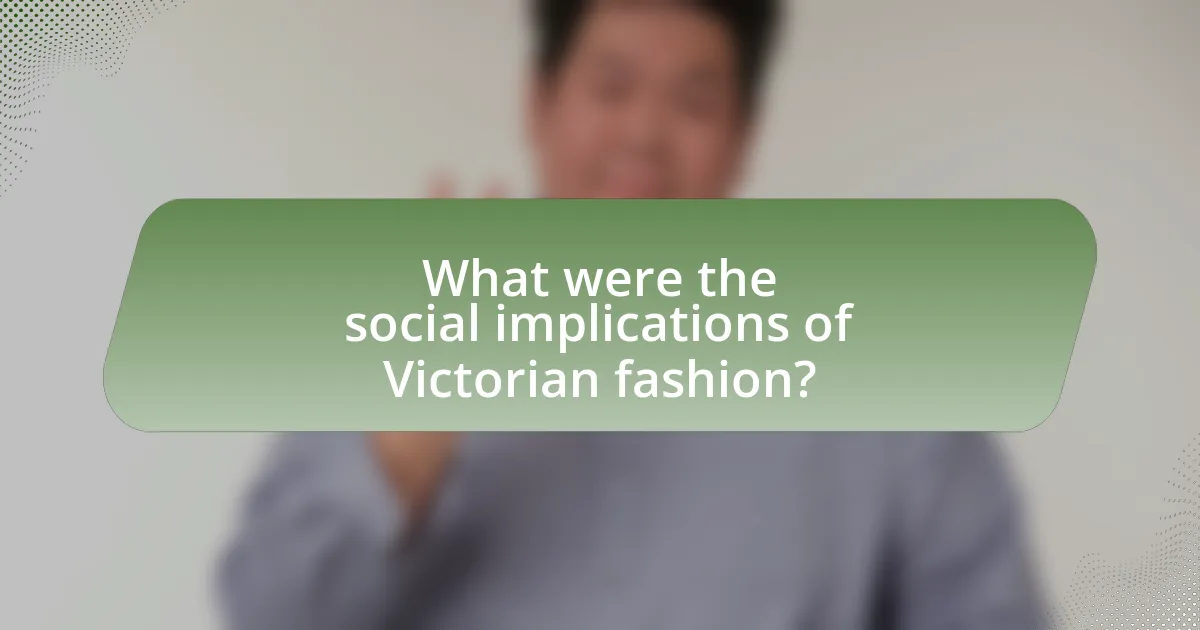
What were the social implications of Victorian fashion?
Victorian fashion had significant social implications, reflecting class distinctions and gender roles of the era. The elaborate styles and materials used in clothing, such as corsets for women and tailored suits for men, reinforced societal expectations regarding femininity and masculinity. For instance, the use of corsets not only shaped women’s bodies but also symbolized their restricted roles within society, emphasizing ideals of modesty and domesticity. Additionally, the fashion industry during this period became a marker of social status, as wealthier individuals could afford the latest trends, while the working class often wore simpler, more practical clothing. This disparity highlighted the class divide and influenced social mobility, as clothing became a means of expressing one’s social identity. The rise of department stores and fashion magazines further democratized fashion, allowing broader access to styles, yet still perpetuating the notion of aspiration tied to wealth and class.
How did fashion reflect the values of Victorian society?
Fashion in Victorian society reflected values such as modesty, class distinction, and gender roles. The elaborate clothing styles, including corsets for women and tailored suits for men, emphasized a strict adherence to social norms and expectations. For instance, women’s fashion prioritized modesty and propriety, with high necklines and long skirts symbolizing virtue and respectability, while men’s fashion showcased wealth and status through the use of fine fabrics and accessories. Additionally, the Industrial Revolution influenced fashion accessibility, allowing the middle class to adopt styles previously reserved for the elite, thus reinforcing class distinctions. Overall, Victorian fashion served as a visual representation of societal values, illustrating the importance placed on morality, social hierarchy, and gender expectations.
What messages did clothing convey about morality and respectability?
Clothing in the Victorian Era conveyed messages of morality and respectability by reflecting societal norms and values regarding class, gender, and propriety. For instance, the use of modest fabrics and designs, such as high necklines and long skirts for women, symbolized virtue and moral integrity, while the absence of such features often indicated a lack of respectability. Additionally, the emphasis on tailored suits and clean, well-fitted garments for men signified professionalism and social status, reinforcing the idea that one’s clothing choices were directly linked to their moral character and societal standing. Historical evidence shows that individuals who deviated from these clothing norms faced social ostracism, further solidifying the connection between attire and moral judgment during this period.
How did fashion contribute to the identity of the middle class?
Fashion significantly contributed to the identity of the middle class by serving as a means of social distinction and self-expression. During the Victorian Era, the middle class utilized fashion to differentiate themselves from both the working class and the aristocracy, adopting styles that reflected their values of respectability and upward mobility. The rise of ready-to-wear clothing and department stores made fashionable attire more accessible, allowing the middle class to showcase their economic status and aspirations through their clothing choices. This shift is evidenced by the popularity of tailored suits for men and elaborate dresses for women, which symbolized a departure from the utilitarian garments of the working class. Furthermore, fashion magazines and advertisements of the time promoted specific styles that reinforced middle-class ideals, emphasizing modesty and propriety, thus solidifying their social identity within the broader Victorian society.
What role did fashion play in social mobility during the Victorian Era?
Fashion played a significant role in social mobility during the Victorian Era by serving as a means for individuals to signal their social status and aspirations. The ability to purchase and wear fashionable clothing allowed members of the emerging middle class to emulate the styles of the upper class, thereby enhancing their social standing. For instance, the proliferation of department stores and ready-to-wear garments made fashionable attire more accessible, enabling individuals from lower socioeconomic backgrounds to adopt styles that were previously exclusive to wealthier classes. This shift is evidenced by the rise of fashion magazines, such as “The Queen” and “The Lady,” which popularized trends and provided guidance on how to dress to impress, further democratizing fashion and its association with social mobility.
How did access to fashion influence social status?
Access to fashion significantly influenced social status during the Victorian Era by serving as a visible marker of wealth and class distinction. The ability to purchase and wear the latest styles, often made from luxurious materials, indicated a higher social standing, while those unable to afford fashionable clothing were often perceived as lower class. For instance, the introduction of mass-produced clothing in the mid-19th century allowed some segments of the population to access fashionable attire, yet the quality and exclusivity of garments remained a strong indicator of social hierarchy. Historical records show that the wealthy often employed dressmakers to create custom outfits, further solidifying their status, as seen in the elaborate gowns worn by upper-class women at social events. Thus, fashion not only reflected individual identity but also reinforced societal structures based on economic power and class.
What impact did fashion have on women’s rights and suffrage movements?
Fashion significantly influenced women’s rights and suffrage movements by serving as a form of expression and a tool for social change. During the Victorian Era, restrictive clothing, such as corsets, symbolized the limitations placed on women, while the adoption of more practical attire, like bloomers, represented a push for freedom and equality. The suffragettes utilized fashion strategically; for instance, they wore white dresses to symbolize purity and used colors like purple, white, and green to represent their movement, which helped to unify and promote their cause. Historical evidence shows that as women began to adopt more functional clothing, it paralleled their fight for rights, demonstrating a direct correlation between fashion choices and the broader struggle for gender equality.
How did fashion trends vary across different regions of the Victorian Empire?
Fashion trends across different regions of the Victorian Empire exhibited significant variation influenced by local culture, climate, and social status. In Britain, fashion was characterized by elaborate dresses with corsets and crinolines, reflecting the influence of Parisian styles. In contrast, India saw the incorporation of traditional garments like the sari, blended with British elements, showcasing a fusion of styles. Australia favored practical clothing suited for its climate, leading to simpler designs. Additionally, regions like Canada adopted British styles but adapted them for functionality in colder weather. These regional differences highlight how local customs and environmental factors shaped the fashion landscape within the Victorian Empire.
What were the differences in fashion between urban and rural areas?
Urban fashion during the Victorian Era was characterized by more elaborate and diverse styles, reflecting the latest trends and influences from fashion capitals, while rural fashion tended to be simpler and more practical, focusing on functionality and durability. In urban areas, individuals had access to a wider variety of fabrics, patterns, and designs, often influenced by the latest Parisian styles, which included intricate details, corsets, and accessories. Conversely, rural fashion prioritized comfort and utility, with clothing made from sturdier materials suitable for labor, such as wool and cotton, and often featured less ornamentation. This distinction was evident in the contrast between the ornate dresses and tailored suits of city dwellers and the plain, functional attire of those in the countryside, reflecting the social and economic disparities of the time.
How did colonial influences shape local fashion trends?
Colonial influences significantly shaped local fashion trends by introducing new materials, styles, and cultural elements from colonized regions. For instance, the British Empire’s expansion brought fabrics like silk and cotton from India, which were incorporated into Victorian clothing, leading to a fusion of local and colonial aesthetics. Additionally, the adoption of exotic motifs and designs from colonized cultures became fashionable among the British elite, reflecting a desire for status and sophistication. This blending of styles not only transformed everyday attire but also influenced high fashion, as seen in the popularity of garments like the tea gown, which combined Western silhouettes with Eastern fabrics.
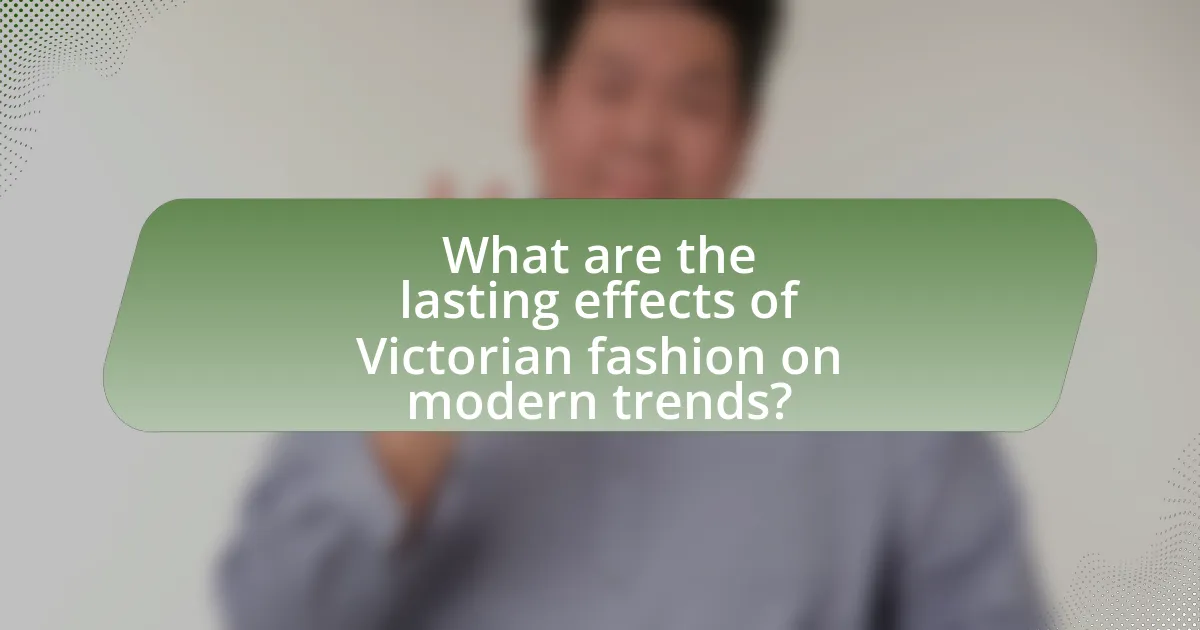
What are the lasting effects of Victorian fashion on modern trends?
Victorian fashion has significantly influenced modern trends, particularly in the realms of silhouette, fabric choice, and ornamentation. The hourglass silhouette, characterized by corsets and full skirts, has inspired contemporary designs that emphasize waistlines and feminine shapes, evident in modern dresses and tailored garments. Additionally, the use of luxurious fabrics such as silk and lace, popularized during the Victorian era, continues to be favored in high fashion today, reflecting a preference for quality materials. Furthermore, the intricate detailing and embellishments seen in Victorian clothing, such as ruffles and embroidery, have re-emerged in modern fashion collections, showcasing a blend of historical aesthetics with contemporary styles. These lasting effects highlight the enduring legacy of Victorian fashion in shaping current sartorial choices.
How does Victorian fashion continue to influence contemporary styles?
Victorian fashion continues to influence contemporary styles through the revival of elements such as corsetry, lace, and high-necked blouses. Designers often draw inspiration from the intricate detailing and structured silhouettes characteristic of the Victorian era, integrating these features into modern garments. For instance, the use of corsets has seen a resurgence in fashion, with contemporary designers like Alexander McQueen and Dolce & Gabbana incorporating them into their collections, reflecting the Victorian emphasis on form and femininity. Additionally, the popularity of Victorian-inspired accessories, such as chokers and ornate jewelry, highlights the lasting impact of this historical period on current fashion trends.
What elements of Victorian fashion are still present in today’s clothing?
Elements of Victorian fashion that are still present in today’s clothing include corsetry, high collars, and intricate embellishments. Corsets, which were essential for achieving the hourglass silhouette in the Victorian era, have evolved into modern shapewear that emphasizes body contouring. High collars, once a staple in Victorian attire, are now seen in contemporary blouses and dresses, reflecting a return to structured necklines. Additionally, intricate embellishments such as lace, ruffles, and embroidery, which were prominent in Victorian garments, continue to influence modern fashion designs, showcasing a blend of historical aesthetics with current trends. These elements demonstrate the lasting impact of Victorian fashion on contemporary clothing styles.
How do modern designers draw inspiration from the Victorian Era?
Modern designers draw inspiration from the Victorian Era by incorporating its intricate patterns, rich fabrics, and elaborate silhouettes into contemporary fashion. This influence is evident in the use of lace, corsetry, and high collars, which reflect the ornate aesthetics of the time. Designers often reference Victorian motifs such as floral prints and brocade, blending them with modern cuts to create a juxtaposition of historical and contemporary styles. The resurgence of Victorian-inspired fashion can be seen in collections from brands like Alexander McQueen and Gucci, which have utilized these elements to evoke a sense of nostalgia while appealing to modern sensibilities.
What lessons can be learned from the fashion of the Victorian Era?
The fashion of the Victorian Era teaches lessons about the intersection of social class, gender roles, and identity. Victorian clothing reflected strict societal norms, where elaborate garments indicated wealth and status, as seen in the use of expensive fabrics and intricate designs. For example, the corset symbolized women’s restricted roles and societal expectations, highlighting how fashion can enforce gender norms. Additionally, the era’s emphasis on modesty and propriety in dress illustrates how clothing can serve as a means of social control. These lessons reveal that fashion is not merely aesthetic but also a powerful tool for expressing and reinforcing cultural values and social hierarchies.
How can understanding Victorian fashion inform current fashion practices?
Understanding Victorian fashion can inform current fashion practices by highlighting the significance of historical context, social class distinctions, and gender roles in clothing design. Victorian fashion was characterized by elaborate garments that reflected societal norms and values, such as the use of corsets to shape women’s bodies, which can inspire contemporary designers to consider how clothing influences identity and social perception. Additionally, the Victorian era’s emphasis on craftsmanship and detail can encourage modern fashion to prioritize quality and sustainability, as seen in the resurgence of handmade and bespoke clothing. Historical analysis reveals that Victorian fashion was not only about aesthetics but also about communicating status and morality, which remains relevant in today’s fashion discourse, where brands often convey messages through their designs.
What best practices can be adopted from the Victorian approach to fashion?
The best practices that can be adopted from the Victorian approach to fashion include an emphasis on craftsmanship, attention to detail, and the use of high-quality materials. Victorian fashion was characterized by intricate designs, tailored fits, and elaborate embellishments, which reflect a commitment to quality and artistry in clothing production. This era also prioritized modesty and propriety, influencing contemporary fashion to consider cultural and social contexts in design choices. The Victorian practice of layering garments can inspire modern fashion to embrace versatility and functionality, allowing for adaptability in various settings. Additionally, the focus on sustainability through the use of durable fabrics and the practice of mending and repurposing clothing can inform current sustainable fashion initiatives.
